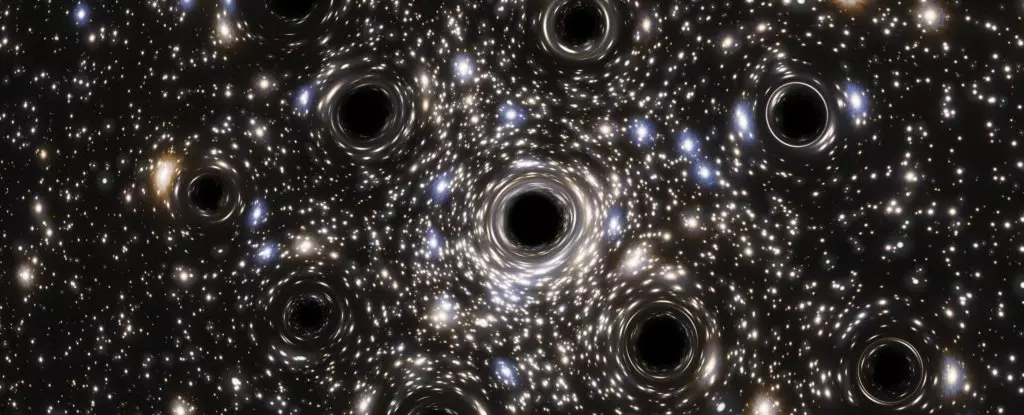The vastness of the universe often conceals its most intriguing secrets in clusters of stars, where patterns of stellar evolution unfold over billions of years. One particular focal point of interest is the globular cluster known as Palomar 5, a celestial formation that stretches 30,000 light-years across the cosmos. An exploration of Palomar 5 has unveiled a fascinating possibility: it may harbor over 100 stellar-mass black holes. This article delves into the significance of this discovery and what it reveals about the nature of globular clusters and stellar streams.
Globular clusters like Palomar 5 are often referred to as “fossils” from the early universe, offering invaluable insights into the conditions and processes that shaped the cosmos. These dense, spherical formations contain between 100,000 and 1 million ancient stars, all of which originated from the same primordial cloud of gas. This uniformity allows astronomers to utilize clusters as chronological markers in studying the universe’s history. The Milky Way galaxy itself is home to over 150 globular clusters, each serving a vital role in our understanding of cosmic phenomena, including dark matter distribution.
While globular clusters have long been a focus of astronomical research, a newer class of stellar formations is gaining prominence: tidal streams. These elongated structures, formed from gravitational interactions, offer additional perspectives on the dynamic processes occurring within our galaxy. Previously difficult to pinpoint, advancements in technologies such as the Gaia space observatory have facilitated the identification of these streams, revolutionizing our understanding of galactic dynamics.
The Tidal Streams of Palomar 5
Palomar 5 is unique in that it possesses both a loosely distributed collection of stars and a pronounced tidal stream stretching across more than 20 degrees of the night sky. This peculiarity has made it an intriguing subject for astrophysical study. Mark Gieles, an astrophysicist from the University of Barcelona, highlights the significance of this cluster in understanding the formation of tidal streams, cautioning that the true origins remain uncertain. Although one theory suggests that tidal streams are remnants of disrupted star clusters, no recently identified streams have had associated star clusters — until Palomar 5.
The exploration of Palomar 5’s stellar system has involved employing sophisticated N-body simulations, which reconstruct the orbits and interactions of individual stars. These simulations have included the potential influence of black holes, which have been shown to interact gravitationally with surrounding stars. The insights gained from these simulations suggest that a considerable population of stellar-mass black holes may be integral to understanding the current configuration of Palomar 5.
The Role of Black Holes
The results emerging from the simulations indicate a significant presence of black holes within Palomar 5. Researchers have determined that the number of black holes could be approximately three times higher than initially anticipated, constituting over 20 percent of the cluster’s total mass. Each of these black holes, with masses around 20 times that of our Sun, likely formed from the supernova remnants of massive stars when the cluster itself was still in its infancy.
This abundance of black holes presents crucial implications for the evolution of the cluster. The gravitational interactions resulting from these black holes would have contributed to slingshot effects, ejecting stars from their original orbits and transforming the cluster’s structure over time. Consequently, the simulations suggest that, as Palomar 5 continues to evolve, it will ultimately dissolve into a stellar stream, populated predominantly by black holes.
The simulations predict that within approximately a billion years, Palomar 5 will have dispersed entirely, leaving behind a complex tapestry of stellar streams and black holes orbiting the Milky Way. This finding, while specific to Palomar 5, hints at a broader trend among globular clusters in our galaxy. Over time, many other clusters may share a similar fate. These insights not only enhance our understanding of the lifecycle of star clusters but also extend our search for black holes that may eventually merge, leading to the formation of more massive black holes.
The implications of these findings resonate well beyond just Palomar 5. As researchers continue to study globular clusters, they may unlock the secrets to understanding the elusive category of middleweight black holes, which remain an enigma amidst the larger stellar framework. Through this exploration, the universe remains a vast and complex playground, inviting astronomers to further unravel its mysteries. Understanding Palomar 5 places us one step closer to deciphering the intricate cosmic dance between stars, black holes, and the fabric of our galaxy.

